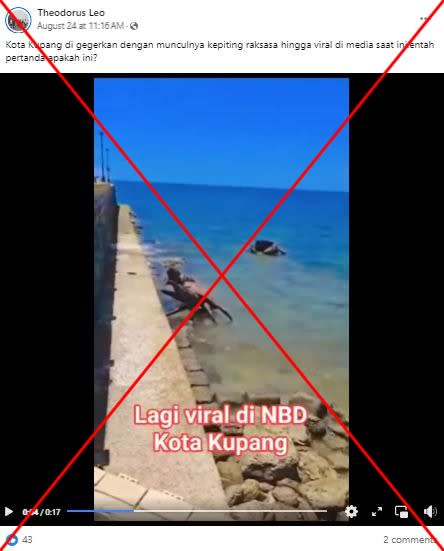A video of an art installation in Spain has been viewed thousands of times in social media posts that falsely portrayed it as showing actual giant crabs washed up on a beach in Kupang, the capital of Indonesia’s East Nusa Tenggara province. Images on Google Maps from a town on Spain’s Atlantic coast show the same installation, which, according to the artist’s website, was made of recycled materials.
“Kupang is shocked by the appearance of giant crabs that went viral. What omen is this?” read the Indonesian-language caption of the clip shared on Facebook on August 24, 2024.
“This is viral in NBD at Kupang city,” text that overlaid the clip added, using the acronym for Nunbaun Dela coastal subdistrict in Kupang.
The 17-second video — watched more than 7,900 times — appears to show two giant crabs on a shore near a concrete wall.
The video has been shared repeatedly on Instagram, Facebook, SnackVideo, YouTube, X and TikTok here and here. Similar claims have been circulated by users in India and Malaysia.
Comments on the posts indicate many social media users believed the claim.
“That’s not a good sign brother.. Stay alert and keep praying so we can be kept away from bad things,” one wrote.
“That’s terrifying,” another said.
Artwork in Spain
A reverse image search of keyframes on Google found the video uploaded to TikTok on June 23, 2024 by user @felixcebrian0 (archived link).
The video was later featured on the MSN news portal with the caption: “On June 23, 2024, near the shore in Chipiona, Spain, a surprising scene unfolded as two massive crabs awaited their turn to be lifted by cranes. In a video shared by @felixcebrian0, these giant crustaceans stood prominently, capturing the attention of onlookers with their impressive size” (archived link).
Below is a screenshot comparison of the video in the false post (left) and the one from TikTok (right):
The same TikTok account had posted another video earlier that day showing people working on the crab sculptures which were hoisted by cranes (archived link).
Keyword searches on Google Maps using the location Chipiona and the terms “cangrejo” and “gigante” — Spanish for “crab” and “giant” — found several corresponding pictures geotagged to the seaside town in Cadiz province, Spain (archived link).
Below is a screenshot of the video in one of the false posts (left) and a geotagged photo from Google Maps (right):
Pictures of the art installation were also uploaded to the Facebook page of the Chipiona town council on June 22, 2024 (archived link).
The post said the artwork was created by artist Alfredo Zarazaga (archived link).
On his website, Zarazaga said his giant sculpture “Crabs on the coast” required 4,300 kilogrammes (9,480 pounds) of recycled iron to make and aimed to increase awareness of the importance of protecting marine diversity (archived link).
EMEA Tribune is not involved in this news article, it is taken from our partners and or from the News Agencies. Copyright and Credit go to the News Agencies, email news@emeatribune.com Follow our WhatsApp verified Channel





